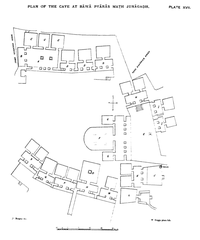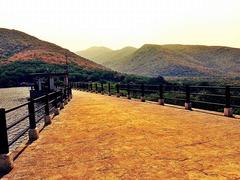
Uparkot Caves Visiting Hours, Tickets, and Complete Guide to Junagadh Historical Sites
Date: 04/07/2025
Introduction
The Uparkot Caves, nestled within the ancient Uparkot Fort complex in Junagadh, Gujarat, represent one of the earliest and most significant examples of Buddhist rock-cut architecture in western India. Dating back to the 2nd–3rd centuries CE, these caves, also known as Khapra Kodiya Caves, offer a compelling window into the cultural, architectural, and spiritual legacy of Junagadh. This comprehensive guide provides detailed information on the history, features, visitor logistics, and cultural context of the Uparkot Caves, ensuring that travelers are fully equipped to appreciate and explore this remarkable heritage site.
Historical Background of Uparkot Caves
Origins and Evolution
The Uparkot Caves are believed to have been excavated during the reign of Emperor Ashoka or shortly thereafter, serving as monastic quarters for Buddhist monks seeking solitude for meditation and study (eindiatourism.in). Their construction coincided with Junagadh’s rise as a center of Buddhist learning, influenced by dynamic trade routes and the region’s multicultural ethos (gujaratexpert.com).
Architectural Features
The caves feature a multi-tiered layout with double-storeyed chambers, interconnected viharas (meditation cells), assembly halls, and water cisterns. Notable architectural elements include:
- Cylindrical pillars: Supporting the ceilings and demarcating spaces, often adorned with Satavahana and Graeco-Scythian motifs.
- Horseshoe-shaped chaitya windows: Allowing natural light to filter in and enhancing the spiritual ambiance.
- Bench-recesses and friezes: With checkerboard patterns and chandrasala motifs above the benches, reflecting the artistic sensibilities of the period (The Brain Chamber).
The caves’ minimalist design, as opposed to the ornate styles of Ajanta or Ellora, reflects the ascetic lifestyle of their Buddhist inhabitants and the emphasis on inner contemplation (Medium).
Historical and Cultural Significance
Uparkot Caves served as a vibrant center for Buddhist monastic life, with advanced water management systems underscoring the monks’ self-sufficiency (eindiatourism.in). Over centuries, despite shifts in political power, the caves remained a testament to Junagadh’s religious diversity and cultural synthesis (gujaratexpert.com). Archaeological documentation by experts like James Burgess has further cemented their status as a key heritage site (ranasafvi.com).
Architectural Highlights
- Multi-tiered design: Optimizes space and provides natural insulation.
- Assembly halls and meditation cells: Support communal gatherings and personal spiritual practice.
- Water cisterns: Demonstrate advanced engineering and self-sustaining monastic life.
- Stylistic blend: Satavahana, Graeco-Scythian, and local influences visible in pillars, motifs, and window designs (Wikipedia).
- Integration with Uparkot Fort: The caves are part of a larger archaeological landscape, including Adi Kadi Vav, Navghan Kuvo, and the Ashokan Rock Edicts (The Brain Chamber).
Cultural and Spiritual Context
Buddhist Heritage
The Uparkot Caves are a profound legacy of Buddhism’s spread in western India, closely tied to Ashoka’s promotion of the faith and the rise of monastic institutions (audiala.com). Their layout—simple, functional, and devoted to meditation—embodies core Buddhist values and the pursuit of enlightenment.
Interfaith Harmony
Junagadh’s landscape is a tapestry of religious traditions, including Hinduism, Jainism, and Islam, with the Uparkot Caves standing as a symbol of religious coexistence and cultural syncretism (explorecity.life). The caves’ proximity to Hindu and Jain temples, as well as Indo-Islamic monuments, highlights Junagadh’s role as a crossroads of faith and culture (gujaratexpert.com).
Visiting Uparkot Caves: Essential Information
Visiting Hours
- Standard hours: Daily from 9:00 AM to 6:00 PM. Some sources mention 8:00 AM as opening time; arriving early is advisable, especially during peak seasons (TheLionLodge.in).
Tickets and Entry Fees
- Indian citizens: INR 20–25
- Foreign nationals: INR 100–200
- Children under 5: Free entry
- Photography: Allowed, but camera fees may apply
Tickets are available only at the on-site counter at the fort entrance.
Accessibility and Facilities
- The caves are accessible via a short walk from the Uparkot Fort entrance.
- The terrain inside is rocky and uneven, with steps—caution and sturdy footwear are advised.
- The site is not fully wheelchair accessible.
- Basic amenities and restrooms are available near the fort entrance; limited facilities are inside the caves.
Guided Tours
- Local guides can be hired at the entrance for a negotiable fee.
- Guided tours are highly recommended to gain deeper insights into the history and cultural significance of the caves.
Photography and Etiquette
- Photography is generally permitted; respect the historical carvings by avoiding flash and not touching surfaces.
- Maintain quiet, especially if visitors are meditating or reflecting.
Sustainability and Preservation
- Do not litter or bring plastic bags.
- Do not mark or deface the stonework.
- Respect restoration projects and preservation guidelines.
Nearby Attractions in Junagadh
Combine your visit to the Uparkot Caves with these nearby historical and cultural sites:
- Adi Kadi Vav: An ancient stepwell within the fort complex.
- Navghan Kuvo: Another historic stepwell.
- Jama Masjid: A mosque within the fort complex.
- Ashokan Rock Edicts: Inscriptions bearing messages from Emperor Ashoka.
- Girnar Hill: A spiritual destination for Hindus and Jains.
- Mahabat Maqbara: An Indo-Islamic mausoleum.
- Junagadh Museum: Artifacts and exhibits on the region’s history.
Best Time to Visit
- Optimal months: October to March (cool and pleasant weather).
- Avoid: Summer (April–June) due to extreme heat, and monsoon season (June–September) when paths may be slippery.
Travel Tips
- Carry water and sun protection (hats, sunscreen, sunglasses).
- Arrive early to avoid crowds and heat.
- Wear comfortable, sturdy shoes.
- Modest clothing is recommended out of respect for the site.
- Supervise children closely due to rocky terrain and steps.
Getting There
- Location: Approximately 2 km from Junagadh railway station.
- Transport: Accessible by auto-rickshaw, taxi, or private vehicle.
- Parking: Available near the fort entrance.
Frequently Asked Questions (FAQ)
Q: What are the Uparkot Caves’ visiting hours?
A: Open daily from 9:00 AM to 6:00 PM.
Q: How much is the entry fee?
A: INR 20–25 for Indians, INR 100–200 for foreigners, free for children under 5.
Q: Can tickets be bought online?
A: No, tickets are available only on-site.
Q: Are the caves accessible for wheelchairs?
A: No, due to ancient steps and uneven terrain.
Q: Are guided tours available?
A: Yes, and they are highly recommended.
Q: Is photography allowed?
A: Yes, but camera fees may apply and flash should be avoided.
Q: What is the best time to visit?
A: October to March.
Q: Can I visit with children?
A: Yes, but supervise them carefully.
Visual Media
Summary and Key Takeaways
The Uparkot Caves of Junagadh are a captivating fusion of Buddhist spirituality, architectural ingenuity, and cultural diversity. Their multi-tiered chambers, carved pillars, and advanced water systems provide a tangible link to India’s ancient past and the region’s role as a crossroads for diverse faiths and cultures. With accessible visiting hours, reasonable ticket prices, and proximity to other historical sites, the Uparkot Caves offer a rewarding and educational experience for all types of travelers. Preservation efforts continue to protect this heritage for future generations, making it a must-visit for anyone interested in India’s spiritual and architectural history.
Sources and Further Reading
- Khapra Kodiya Caves, Junagadh – eindiatourism.in
- Uparkot Fort – GujaratExpert.com
- The Buddhist Caves in Uparkot Junagadh Fortress – Ranasafvi.com
- Uparkot Caves – The Brain Chamber
- Buddhist Caves & Stepwell Uparkot Fort Junagadh Gujarat – ExploreMyWays.com
- The Buddhist Caves of Uparkot: A Journey Through Ancient Art and Spirituality – Medium.com
- Buddhist Caves – UparkotFort.com
- Khapra Kodiya Caves, Junagadh – Audiala.com
- Junagadh – ExploreCity.life
- Uparkot Fort Junagadh – GujaratDarshanGuide.com
- Uparkot Travel Guide – TheLionLodge.in
For more travel tips, historical insights, and exclusive guides, download the Audiala app and follow us on social media to stay updated on Junagadh’s cultural treasures and beyond.




